Awang Goneng's Blog
October 14, 2013
Eid Mubarak - Eid al Adha
The Lord Laughs Last
 If Headley had an imposing title, the man had a higher one. He was ‘Lord of Thailand’ residing in Kuala Trengganu, in ‘Ladang School’s Vllge’, which I take to be Kampung Ladang Sekolah in ordinary parlance. I knew the place well as I went to school there, two schools in fact, one alongside the other. This Lord of Thailand revealed himself as Tengku Abdullah Osman. The purpose of this letter was baffling as I could not fathom what he was trying to convey to Mr Headley, and I suspect Mr Headley too would not have been able to make head or tail of his mission. It was polite in tone, full of Malay style salutations, too full in fact as to create a haze over the content. I even suspected that it was originally written in Malay and then translated – very literally – by someone else with an Malay-English dictionary at hand. It spoke, probably of two comrades in arms (“Brother-Army”) who died (as I gathered from the phrase “Death corpse”), and the letter writer, in all earnestness, prayed that they be despatched to “Soul-Heaven”. And he also – I think – wanted the British army to dress in mourning for two days or perhaps in “two days time” after his letter. Some people have guessed from the desperate note that this was a former Thai local dignitary seeking to ingratiate himself to the new overlords. And I though they could well have been right for it is not unusual for old coat-hangers to seek new apparels. And then, last week in Facebook, my friend Wan M Yusoff posted about his meeting with his ‘favourite storyteller’ in Kuala Trengganu, Pak Wan Abas, a man long in the tooth but with a very clear mind still for events in the past. I asked Wan Yusoff to record his conversation(s) for future generations. And then, there was this throwaway line in his post: “I did not know that Trengganu was under Thai rule during the Japanese occupation.” Yes, Trengganu was indeed ruled by Siam, I commented, and to prove that I attached a picture of Thai-issued stamps with the ‘Trengganu’ postmark. And then, I added, there was something strange: when the British came back, a man who styled himself ‘Lord of Thailand’ wrote a letter to one Mr Headley with content that I found hard to understand. Could he ask Pak Wan Abas if he knew who this Tengku Abdullah Osman of ‘Ladang School’s Vllge’ was?
If Headley had an imposing title, the man had a higher one. He was ‘Lord of Thailand’ residing in Kuala Trengganu, in ‘Ladang School’s Vllge’, which I take to be Kampung Ladang Sekolah in ordinary parlance. I knew the place well as I went to school there, two schools in fact, one alongside the other. This Lord of Thailand revealed himself as Tengku Abdullah Osman. The purpose of this letter was baffling as I could not fathom what he was trying to convey to Mr Headley, and I suspect Mr Headley too would not have been able to make head or tail of his mission. It was polite in tone, full of Malay style salutations, too full in fact as to create a haze over the content. I even suspected that it was originally written in Malay and then translated – very literally – by someone else with an Malay-English dictionary at hand. It spoke, probably of two comrades in arms (“Brother-Army”) who died (as I gathered from the phrase “Death corpse”), and the letter writer, in all earnestness, prayed that they be despatched to “Soul-Heaven”. And he also – I think – wanted the British army to dress in mourning for two days or perhaps in “two days time” after his letter. Some people have guessed from the desperate note that this was a former Thai local dignitary seeking to ingratiate himself to the new overlords. And I though they could well have been right for it is not unusual for old coat-hangers to seek new apparels. And then, last week in Facebook, my friend Wan M Yusoff posted about his meeting with his ‘favourite storyteller’ in Kuala Trengganu, Pak Wan Abas, a man long in the tooth but with a very clear mind still for events in the past. I asked Wan Yusoff to record his conversation(s) for future generations. And then, there was this throwaway line in his post: “I did not know that Trengganu was under Thai rule during the Japanese occupation.” Yes, Trengganu was indeed ruled by Siam, I commented, and to prove that I attached a picture of Thai-issued stamps with the ‘Trengganu’ postmark. And then, I added, there was something strange: when the British came back, a man who styled himself ‘Lord of Thailand’ wrote a letter to one Mr Headley with content that I found hard to understand. Could he ask Pak Wan Abas if he knew who this Tengku Abdullah Osman of ‘Ladang School’s Vllge’ was?
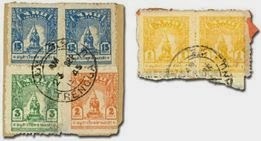 Wan Yusoff visited the ailing Pak Wan Abas again. And what laughter it brought me on a very wet Saturday afternoon in London and in Kuala Trengganu, in the home of the venerable story-telling gentleman as Wan Yusoff broached the question. History and a man who we had always regarded as a figure of fun was having the last laugh on us and I - like a madman – could no longer control laughter spewing from my mouth with the tea that I was enjoying by myself in the Great Court of the British Museum. We were communicating in real time through the medium of FB. Things that had been torn apart were now falling back in place. It brought us back to childhood times, to Kampung Ladang, and to a man I often wrote about in my blogs as Ku Löh Nayar. As Ku is the Trengganu dimunitive for Tengku, and Löh, the shortened Abdullah, there you have him before your eyes and in your mind, the Lord of Thailand Tengku Abdullah Osman was none other than our Ku Löh Nayar, the disturbed man who terrified us for almost our entire Trengganu schooldays, a local character and the eminently unhinged. His letter to Mr Headley is now in the safekeeping of the National Archives of Australia, indexed under the item ‘Letter of congratulations of Tengku Abdullah Osman 21 October 1945’. All this happened during the short reign of Sultan Ali who was installed Sultan when his father, Sultan Sulaiman Badrul Alam Shah of the Istana Kolam died. {see report from the New Straits Times, below] Thank you Pak Wan Abas, may Allah preserve you, and to Wan M Yusoff for helping to solve this long (and hilarious) mystery. Thank you to the blogger Le Minh Khai for having brought this letter to my attention.
Wan Yusoff visited the ailing Pak Wan Abas again. And what laughter it brought me on a very wet Saturday afternoon in London and in Kuala Trengganu, in the home of the venerable story-telling gentleman as Wan Yusoff broached the question. History and a man who we had always regarded as a figure of fun was having the last laugh on us and I - like a madman – could no longer control laughter spewing from my mouth with the tea that I was enjoying by myself in the Great Court of the British Museum. We were communicating in real time through the medium of FB. Things that had been torn apart were now falling back in place. It brought us back to childhood times, to Kampung Ladang, and to a man I often wrote about in my blogs as Ku Löh Nayar. As Ku is the Trengganu dimunitive for Tengku, and Löh, the shortened Abdullah, there you have him before your eyes and in your mind, the Lord of Thailand Tengku Abdullah Osman was none other than our Ku Löh Nayar, the disturbed man who terrified us for almost our entire Trengganu schooldays, a local character and the eminently unhinged. His letter to Mr Headley is now in the safekeeping of the National Archives of Australia, indexed under the item ‘Letter of congratulations of Tengku Abdullah Osman 21 October 1945’. All this happened during the short reign of Sultan Ali who was installed Sultan when his father, Sultan Sulaiman Badrul Alam Shah of the Istana Kolam died. {see report from the New Straits Times, below] Thank you Pak Wan Abas, may Allah preserve you, and to Wan M Yusoff for helping to solve this long (and hilarious) mystery. Thank you to the blogger Le Minh Khai for having brought this letter to my attention.

October 24, 2012
Drawn From memory
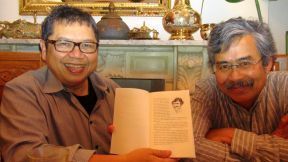 Readers of both Growing Up in Trengganu and A Map of Trengganu will have noticed a pen drawing of the author atop his bio-data. It was drawn by my good friend Lat (Datuk Mohd Nor Khalid) from memory, and the last time I saw him before he drew that must have been years upon donkey's ears ago.
Readers of both Growing Up in Trengganu and A Map of Trengganu will have noticed a pen drawing of the author atop his bio-data. It was drawn by my good friend Lat (Datuk Mohd Nor Khalid) from memory, and the last time I saw him before he drew that must have been years upon donkey's ears ago.There is this line that I always pull when Lat and I are together. We're both writing a book together where Datuk Lat will be doing the text and I'll be drawing the pictures. In reality the joke is on me for the Datuk is not only a widely read man and an able writer but also a very amusing raconteur.
We had a reunion last Monday and then on Tuesday. The Monday meeting also brought Cheryl Dorall, respected fellow journalist, former Malay Mail columnist and distinguished former editor of the Sunday Star. They, my mate Kak Teh and myself made the former New Straits Times old timers' combo at the Holiday Villa in Londra. We were also joined by Mohamad Jefri, Holiday Villa's manager.
The picture above shows how successful Datuk Lat was when drawing from memory. Thank you, Sir!
August 17, 2012
The Good Ship Hari raya
 Ramadan sails away ever so swiftly, even before the nekbat's gone dry in the cupboard of neglect and the hasidöh pulls out in slippery tendons of rope, and we are up to our eyeballs in bubor lambok with its limp tendrils of pucuk paku and the sprinkling of budu.
Ramadan sails away ever so swiftly, even before the nekbat's gone dry in the cupboard of neglect and the hasidöh pulls out in slippery tendons of rope, and we are up to our eyeballs in bubor lambok with its limp tendrils of pucuk paku and the sprinkling of budu.We are now going a-sailing, the seafaring people on the shore of Ujung Tanjong in Kuala Trengganu for it has always been in us, wind blasted souls encrusted with salt to the core, brine and brackish water in the Pantai Teluk with skeletons of abandoned boats that came back and could take the journey no more to Senggora; ikang belukang and tiny crabs peering out from the mud, pincer-waving to one and all.
We have made this frame from thin bamboo, stolen probably from the bamboo hedge of the Sekölöh Paya Bunga, glossy paper from Indian shops, red and green and blue, and streamers entwined from crepe paper and gaps in the ship patched up - so as not to strain the budget - with old copies of the Straits Times and Utusan Melayu.
They call it tujuh likor, a word that has long vanished from our everyday tongue. What is likor? And why seven of them in this lengthening month of puasa? It is time for ships standing in the front yard of our houses and bamboo cannons blasting away carbide fumes and deafening the cries of mothers and excited children and the voice of Pök Lèh from the surau.
Ramadan has been a-sailing so quickly but never too quickly for a child. The night is flickering with lights and shadows and paraffin and whiffs of carbide in the air. Rushed is the iftar, rushed is the prayers of children of prayerful people for this is the night of the beginning of the month of Shawwal.
The day after this is Hari Raya, oh the day after that perhaps, it all depends on the moon in the sky but oh joy is the night and food on plates, and ketupat and kuah kacang and beleda, the dry, sugar-coated coloured jewels.
Would Hari Raya come every day, would all those past Rayas that have gone lost in the mists of years, would they all come back now, for now is the time for forgiving, for visits to past people all lying in the solace of their earthly beds marked with stones, time for children everywhere to feel a little rich, for a while.
Dear Readers: Selamat Hari Raya. I have been away on a ship and have just come back to shore.
Raya image courtesy of Ethnic Minority Liberal Democrats.
June 30, 2012
Letter From America
Dear and esteemed Awang Goneng,Thank you, Sir, may God bless you too. A Map of Trengganu is still available from online retailers and from Foyles in London and good bookshops in Malaysia and Singapore. Or from the Pizzaman at large in Malaysia: SMS, 019-3199788 (Karim); email, akarimomarATyahoo.comI am hopeful that you are blessed with good health as much as you have blessed your readers with your prose.
I have not written in a while, but learned you had published your second book a while ago. I purchased it "A Map of Trengganu" and wanted to express my deepest thanks to you. I began the reading and within a few pages already knew that this latest work would bring me moments of happiness as well as melancholy, because as conscious beings, the past will always bring happiness as well as sadness. Sadness in the way that one yearns to relive or go back to a time of innocence as well as a time of remembrance of days past, memories of loved ones who have past one's way - it is the circle of life, so to say. But, I was totally surprised to see your thanks to me about the incense burner! I felt that I was now part of your book and it made me so appreciative of life and sharing with others, like you have shared with your readers.
I hope that God blesses you with a long and healthy life so that I can "selfishly" live from your future works; you are so gifted with words and your story is so transitive, it crosses over into all walks of life. Reading your stories allows me to relive mine. I hope you do well in what ever you do. You are an incredible soul.
Sincerely,
Louis Crespo
New York
May 10, 2012
Every Day Rainy Beats
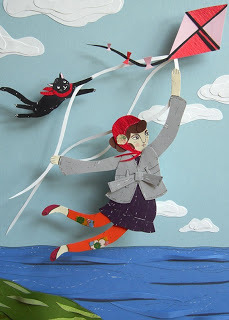 In Kuala Trengganu the monsoon sings a tune that rattles on corrugated roofs that lulls cats to sleep. Fishermen home from the sea for a long snooze on the veranda, awaiting the wife's return with tapioca and stuff. But stuff is for the night, it's the ubi that now lifts the spirit, hissing out warm air in clouds as root turns translucent white. Tapioca and shaved coconut with salt from the sea now roaring mad, once the fisherman's ground, now his dread. Sounds of distant thunder beneath clouds rolling dark. Pedicab pushers sitting under tarpaulins rat-a-tatting with sudden drops, window panes shielding the constant patter, travellers curled in trishaws, sitting behind waterproof sheets, listening to rubber dipping into bumps in the road, sprays of rain squelching beneath lorry tires, and the chatter of rain-soaked trishawman drenched beneath his hat. The patter and the squelch and the bumps and the drones; the jabber and the damp. In a milieu of patter and beats. These are everyday parts, assembled in rhythm and sounds...
In Kuala Trengganu the monsoon sings a tune that rattles on corrugated roofs that lulls cats to sleep. Fishermen home from the sea for a long snooze on the veranda, awaiting the wife's return with tapioca and stuff. But stuff is for the night, it's the ubi that now lifts the spirit, hissing out warm air in clouds as root turns translucent white. Tapioca and shaved coconut with salt from the sea now roaring mad, once the fisherman's ground, now his dread. Sounds of distant thunder beneath clouds rolling dark. Pedicab pushers sitting under tarpaulins rat-a-tatting with sudden drops, window panes shielding the constant patter, travellers curled in trishaws, sitting behind waterproof sheets, listening to rubber dipping into bumps in the road, sprays of rain squelching beneath lorry tires, and the chatter of rain-soaked trishawman drenched beneath his hat. The patter and the squelch and the bumps and the drones; the jabber and the damp. In a milieu of patter and beats. These are everyday parts, assembled in rhythm and sounds... Budök budök mmaing wa
Atah jambatang
Lang kangök, lang kangök
dok terbang
Anök-anök dok nnöcak
Ssèmbak rötang
Jatoh ddebök, jatoh ddebök
ddalang lökang
Cik Mbong makang kerepok
ikang tambang
cicöh cuka, cicöh cuka
Awang Hitang
Cik Kalèh göhék tèksi
Ddalang hujang
Lapu lik-lak, lapu lik-lak
Ddalang pikirang
Ddölöh Hasang mamöh daging
Kena tulang
Ggögèh gigi, ggögèh gigi
Dök setarang
Kucing bapök masok dapor
Bahang ikang
Pacör-kecing, pacör kecing
Ddalang ppayang.
Illustration: Fly by Kite by Jayme McGowan. With thanks
January 25, 2012
Stamping Around the World
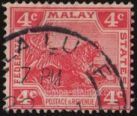 and that was his album. He kept his entire collection in there, stamps still stuck to shreds of envelope paper, used stamps with glueless backs, waiting to be assigned to country pages in an album that he never bought, clusters of mint stamps still clinging to neighbours by their perforated edges, and commemorative envelopes, Queen Elizabeth's coronation, Merdeka day, and some other dates that I don't now remember.
and that was his album. He kept his entire collection in there, stamps still stuck to shreds of envelope paper, used stamps with glueless backs, waiting to be assigned to country pages in an album that he never bought, clusters of mint stamps still clinging to neighbours by their perforated edges, and commemorative envelopes, Queen Elizabeth's coronation, Merdeka day, and some other dates that I don't now remember.He wasn't a serious collector like his neighbour Wang Nawang, who lived three houses away from us, in the same row that looked into the market, but further down to the shore. Wang Nawang stuck his stamps with hinges, in pages of an album that probably bore the Stanley Gibbons insignia. We often saw him sit by his window, looking into his stamp collection, in a cloak of sweet smoke emanating from his pipe tobacco. There he sat, pondering over Monaco triangles, and Ifni birds with smug and quizzical looks perched on long necks, and exotic goats and native people. Where in the world is Ifni now?
Looking into Father's bag of philately I found the name S.A.Latif,
 stamped in blue ink on the back of an envelope that came from Durban, Natal, in South Africa. Latif must have swapped many stamps with Father as he had many Suid-Afrika issues in his bag, but Father had postcards too from lands that stood beyond the further reaches of my imagination, and a medal issued during the coronation of Queen Elizabth II in 1953, and here and there were delightful snippets of life in San Marino and Nyasaland and Ruanda-Urundi, thumb-nailed into postage stamps that carried in them more than a faint glimmer of sunshine in a foreign country. Ruanda-Urundi, a land with people I imagined to be constantly dancing in unfettered joy, what calamity touched it much, much later.
stamped in blue ink on the back of an envelope that came from Durban, Natal, in South Africa. Latif must have swapped many stamps with Father as he had many Suid-Afrika issues in his bag, but Father had postcards too from lands that stood beyond the further reaches of my imagination, and a medal issued during the coronation of Queen Elizabth II in 1953, and here and there were delightful snippets of life in San Marino and Nyasaland and Ruanda-Urundi, thumb-nailed into postage stamps that carried in them more than a faint glimmer of sunshine in a foreign country. Ruanda-Urundi, a land with people I imagined to be constantly dancing in unfettered joy, what calamity touched it much, much later.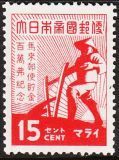 But for all those sounds conjured in vivid mental pictures and the alliterative lure of foreign lands,Father's interest was basically local. His bag was filled with Federated Malay State issues, tigers confined in serrated edges, aroused from jungle slumber; FMS stamps with the BMA overprint, and Trengganu stamps with overprints of Japanese characters and the occupying power's own issues showing a farmer ploughing the Malayan land as rays of the Japanese sun shone behind his field.
But for all those sounds conjured in vivid mental pictures and the alliterative lure of foreign lands,Father's interest was basically local. His bag was filled with Federated Malay State issues, tigers confined in serrated edges, aroused from jungle slumber; FMS stamps with the BMA overprint, and Trengganu stamps with overprints of Japanese characters and the occupying power's own issues showing a farmer ploughing the Malayan land as rays of the Japanese sun shone behind his field.When I too started to collect stamps, I wrote to S.A.Latif in Natal asking if he was ready for further swaps, but Father must have given more than he had pages in his album. "Please do not send me any more stamps as I have more than I need from Malaya," he wrote back, but he also very kindly enclosed some South Africa stamps, and then I heard form him no more. My collection expanded very slowly with occasional replenishments from Father's promiscuous pile, but occasionally I bought stamps from a dealer named Lee Cheng Puan in Duku Road, Singapore. Lee sent us stamps in little booklets from which we picked and then we sent back the rest with cash for the purchase that amounted to no more than a few dollars.
Emboldened by that
 I looked to further shores and found one as I was scouring through TitBits, a magazine that Father occasionally brought home from the Chee Seek store in Kampung China. There were snippets in there of human interest stories, laughter from my favourite cartoonist Clew, Charles Atlas in his leopard skin underwear urging you not to have sand kicked in your eyes by beach bullies. And then, in one corner, were the good people from the London company of Broadway Approvals.
I looked to further shores and found one as I was scouring through TitBits, a magazine that Father occasionally brought home from the Chee Seek store in Kampung China. There were snippets in there of human interest stories, laughter from my favourite cartoonist Clew, Charles Atlas in his leopard skin underwear urging you not to have sand kicked in your eyes by beach bullies. And then, in one corner, were the good people from the London company of Broadway Approvals.Broadway said they sent stamps out on approval, so I wrote to them, and – to my surprise - they did: in a little booklet came Ifni and Monaco and San Marino and Helvetica and more places you could hurry to by turning the pages. They were all sent for your approval, for you to take your pick, and to send back whatever you didn't want to Broadway Approvals plus a postal order for your purchase. I took what I wanted and sold the rest to my classmates, and the whole collection, as I recall, cost $15.00 which was probably about £1 15s 3d in old money.
 The world spun on a different axis in those days when trust was truly global. Which trader would think it wise now to send a collection of stamps halfway around the world to a child in primary school? I found a Broadway Approvals advertisement recently that was almost similar to the one I saw in TitBits and was touched by this tagline in their copy, "But please tell your parents you are answering this advertisement."
The world spun on a different axis in those days when trust was truly global. Which trader would think it wise now to send a collection of stamps halfway around the world to a child in primary school? I found a Broadway Approvals advertisement recently that was almost similar to the one I saw in TitBits and was touched by this tagline in their copy, "But please tell your parents you are answering this advertisement."Broadway Approvals, I have a confession to make after all these years: my parents didn't know.
----------------------
*I have done further research into Broadway Approvals. They were in South London, at 50 Denmark Hill. In 1956 they brought the Micromodel Company, a company credited with the origination of cut-out models of historic buildings and castles. The man behind Broadway Approvals was George Santo. Thank you Mr Santo!
January 21, 2012
Chinese New Year
 To all my Chinese readers, a very happy new year from me and from Pök Téng and Mat Spröng too.
To all my Chinese readers, a very happy new year from me and from Pök Téng and Mat Spröng too.Selamat Tahong Baru!
[Image courtesy of http://1800sunstar.com]
January 5, 2012
A Book In A Quiet Corner
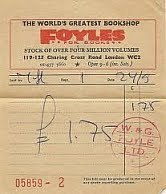 It has been almost a year now since we launched A Map of Trengganu at RA Fine Arts in a place called Solaris Hartamas.The band Diwangga Sakti played, Andre Goh sang, Jimmy Choo wowed shoe lovers, old friends and new inter-mingled, my sister baked cakes for us - old kuihs and new - and a really, really wonderful time was had by all.
It has been almost a year now since we launched A Map of Trengganu at RA Fine Arts in a place called Solaris Hartamas.The band Diwangga Sakti played, Andre Goh sang, Jimmy Choo wowed shoe lovers, old friends and new inter-mingled, my sister baked cakes for us - old kuihs and new - and a really, really wonderful time was had by all.Now the book is still selling well and I want to thank you all.
Yesterday I saw that Foyles of London had a few copies still on their shelves. So if you happen to be in London and would like to read about Trengganu (er, you would like to read that sentence again?) do make your way to Charing Cross. Even if the books are no longer there you'll still enjoy Foyles which, at one time, was the most famous bookshop in the world. Marks & Co (more widely known as 84 Charing Cross Road) made it to the stage, but Foyles fought the war and was both loved and hated for its eccentricities. But it is much better now.
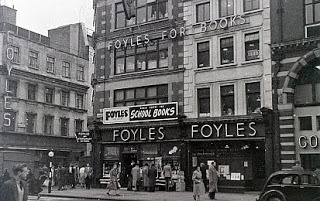 In the second half of my secondary school years, in a school called Victoria Institution (yes, you heard it right, I was once in an institution), our English teacher told us about Foyles, what a big place it was and how he'd spent his days there reading books he couldn't afford to buy. Foyles was - and still is - like that; it leaves you alone amid its chaos and it holds no grudge for your taking your fill of its bibliopolity.
In the second half of my secondary school years, in a school called Victoria Institution (yes, you heard it right, I was once in an institution), our English teacher told us about Foyles, what a big place it was and how he'd spent his days there reading books he couldn't afford to buy. Foyles was - and still is - like that; it leaves you alone amid its chaos and it holds no grudge for your taking your fill of its bibliopolity.I used to spend hours in its occult and philosophy wing wondering about Aleister Crowley, reading about Greeks in a barrel and many other things too weird and wonderful.
In leaner days the building that housed the wing was sold to Waterstones, and then Waterstones grew slimmer and the shop across the road is now taken over by people who divide its ground floor between respectability and semi-pornography, and its basement entirely for the serious study of the scatological.
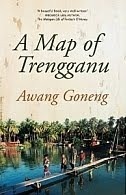 It warms the cockles of my heart of course to know that today, the Foyles that gave comfort to my English teacher in his hours of need, that gave me things to read on dozy afternoons, that is visited by many of the great and good of this metropolis, also stocks A Map of Trengganu.
It warms the cockles of my heart of course to know that today, the Foyles that gave comfort to my English teacher in his hours of need, that gave me things to read on dozy afternoons, that is visited by many of the great and good of this metropolis, also stocks A Map of Trengganu.So, if you're tired of London, as Dr Johnson meant to say, do take yourself there and buy the book, or just read it if you please, and place a discreet bookmark in it for you to return to another day.
December 31, 2011
Green Umbrellas and New Books & Old Wind on the New
I have borrowed this photo from my friend Zaharan Razak's blogpage. Read the story behind it at Zaharan's blog, 'I' of the Hornbill, and its sad postscript here.
Not a lot happened on New Year's day in Kuala Trengganu: the winds blew stronger than ever, what Mother called anging tahong baru. Days have slipped past and months and years do concatenate looking at them from here now, but it could be that it was the Chinese New Year later in January that she was talking about, not the advent of the new one in the Gregorian calendar.
The streets were gusty, I remember, in the build-up to January, and the surf rebounding from the breaker jutting out into the rivermouth swirled above the milky water. It was the air ulu coming down from the interior, root, branches and all. What deep forests it meandered through, what hefty trees stood on the swelling banks to bid it goodbye as it dashed and washed its way through carrying buöh rengas and tendrils and sometimes a dead cow to desposit on our shore, far away.
This was the month when I would go to Mök Möh when the clouds had emptied its all into puddles on the roadside, and rain drenched the clothes of market people. Green umbrellas unfurled and plastic raincoats of schoolboys bicycling in the rain, oh what joy. Mök Möh, when time was opportune, would open a gap in the fence around her compound and she'd light the fire and fill the steamer with well-water and there was light and warmth in her little corner as she steamed putus in a row. Yellow putus with fenugreek, glistening white ones of tapioca, and plain brittle ones from rice flour.
There was something exhilarating about this recess in the rain, when a slight gleam of light peeked from the sky and people poured out from their cover, from houses, from under trees, and boys and girls - and adults too - waded in the water just flowing above the road surface in Kedai Payang. In this overflow from the monsoon drains, as they were called, came dead rats and specks of dirt that stuck to feet and left watermarks on surrounding walls. This moment of joy was called mmaing air, playing in the water, when nubile lasses raised their sarongs to show comely legs, when young lads' thoughts turned to the fanciful, when market traders muttered beneath their breaths at the lack of assistance from their sons or daughters when they were desperately rescuing fruits and vegetables and basketry from the sweep of the flow.
Mök Möh's putu, in all its variety, was comfort food for the weather. Hot and crumbly, dipped in sugar, or taken just as they came between a newspaper page lined with banana leaf until the chewing came to its putu core of coconut sugar. The sticky tapioca putu filled the gap in the belly until dinner time of bubur (broth) and salted fish, or, as we sometimes did in our house - the children I mean - we took rice piping hot and folded ghee into it and then, for the kick, we mixed in bits of red chilli pounded with grainy sea salt in the mortar.
We were sitting now in the dining quarter, the bucolic side of our house as opposed to the front that looked down into the urban market. From here we could look out into the kampung and Pök Wè's mminja trees and those other houses on stilts. The mother hens were not clucking now, nor goats bleated, but from narrow gaps in the floor of our tall house we heard the movements of domestic animals seeking comfort and warmth down below.
The calender was still untouched, the daily one that gave the working days in black and the Sundays in red numbers. On the top sheet, as yet untorn, was the greeting, Happy New Year. And Lin Dai, the Hong Kong film star, was smiling enticingly on the stiff backing card that also bore the name of the shop that gave the calendar to Father.
On his writing desk Father kept the monthly calendar given to him by the Pejabak Ugama (Religious Department), days of the month in little boxes and the festivals and significant days of the were inscribed where they belonged, in Jawi.
There was a bigger version of this monthly record of passing days, also with days in little boxes, that marked Racing days in Ipoh and Kuala Lumpur as well as high days and holy days that we arrived at at specific times of the year - Wesak Day and Thaipusam and the two Hari Rayas and Christmas at the end of the year.
The New Year meant a new school term, new second-hand books in the satchel, new faces perhaps in class and most certainly a new teacher. We had the book-list at the end of the last school year, we ticked at names of books that we could cadge or buy at half the original price from friends, and then, at the beginning of the new school term - in the new year - Father give us a few dollars to buy unticked ones brand new from the school bookshop, pages untouched and pristine since the day the printers put them between covers.
The cocks crowed as usual at dawn and the sun peeked occasionaly from between covers as the new old wind blew uncertainly with the light that shone through the crack of the first day of the new-born year.
God rest ye merry everyone, may nothing you dismay for three-hundred days and a bit more.
Awang Goneng's Blog
- Awang Goneng's profile
- 8 followers



